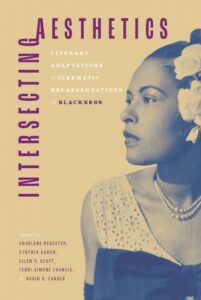
[ad_1]
Writing themselves into existence or responding to oppressive forces and practices that limited their freedom, early twentieth-century African American writers desired to have their voices heard. Paul Laurence Dunbar, Charles Waddell Chesnutt, and writer-filmmaker Oscar Micheaux represent some of the first Black authors whose work garnered the interest of film producers. This first generation demonstrated that their work could be adapted to the screen, but their contributions were limited to independent films produced outside the mainstream industry.
The next generation of Black writers did attract the attention of prominent film enterprises. This second generation evolved from the Harlem Renaissance, which produced an avalanche of literary figures and coincided with the heightened popularity of cinematic production. Authors who attracted Hollywood’s interest include Wallace Thurman, Langston Hughes, Zora Neale Hurston, and Ann Petry. These literary figures had close encounters with the mainstream cinema industry, which could no longer ignore them, given their status as celebrated authors. Still, most did not see their writings translated into Hollywood adaptations.
A third generation of African American writers emerged, and their writings could no longer be dismissed, considering the heightened racial consciousness that erupted during the World War II era. Thus, Black writers Frank Yerby, Willard Motley, and Richard Wright had their novels adapted to the screen, but in the adaptation process, their novels were substantially compromised or marginalized. Certainly, all novels endure alterations when adapted to the screen, but the adaptations based on the work of Black writers often involved considerable restructuring, usually because the studios changed the narratives to appease white audiences.
Illustrating the challenges in mid-century Hollywood, Richard Wright’s 1940 novel, Native Son, was not adapted until 1951, and the production was an independent film rather than a studio release. Acutely aware of Motley and Yerby’s shared disappointment with the screen adaptations of their literary work, Wright assumed a more assertive posture.
In 1940, he began collaboration with white playwright Paul Green to create a theatrical adaptation of Native Son. Wright accepted Green’s involvement, according to historian Kate Dossett, because the way Green handled the Black character in his play Hymn of the Rising Sun made Wright believe he could “‘handle a boy like Bigger,” the protagonist in Native Son. However, “the established white playwright and rising Black star came to very different positions on the role of Bigger.” Despite their disagreements, the 1941 theatrical production of white director Orson Welles starring Black actor Canada Lee as Bigger Thomas “attracted large Broadway audiences.”
The adaptations based on the work of Black writers often involved considerable restructuring, usually because the studios changed the narratives to appease white audiences.
Wright’s literary agent had approached one of the studios in 1939, but this early effort at screen adaptation had failed to materialize. However, the success of the stage production sparked studio interest: “Wright was approached by the Hollywood producer Harold Hecht who was interested in making a film adaptation, but negotiations fell through when Hecht revealed that he wanted to use an all-white cast!” The Chicago Defender reported that Wright found non-negotiable “sticking points” in the studio contract; when he “learned that Hollywood was going to make [the character in] Native Son… a white person, and change various contents of the book…to appease the southern element and other demagogues[,] he quickly refused.”
Disappointed with Hollywood, Wright pursued having his novel dramatized on screen, and he eventually worked with Pierre Chenal (a French director) and Artillo Mentasti (head of Argentine Sono Films) to produce a low-budget, independent film. According to Ebony magazine, “Arrangements for Native Son’s production was a three-continent deal when consummated. The venture was organized in Paris, contracts signed in New York, exteriors shot in Chicago and filming of the story done in Buenos Aires.”
In the deal, Wright retained the novel’s screen rights, controlled the dialogue, served as directorial collaborator, and played the film’s lead, Bigger Thomas. Attesting to Wright’s extensive involvement, Black writer Margaret Walker confirms, “He would write the script, share in financial backing, direct some scenes, and play a major character in the film.” Film historian Donald Bogle sees Wright’s casting as Bigger contributing to the film’s failure; Wright was “Too old, too fat, too weary, too middle class and too successful and sophisticated…[so he] was thoroughly implausible in the role of a tortured youth.” However, the production’s aesthetic limitations do not explain its lack of financial or critical success.
First, as an independent production, Native Son could not compete with studio-backed releases. Second, the 1951 adaptation, which presents a sharp critique of racism in the United States, was released during the Cold War, when anticommunist policies were silencing social criticism, especially in Hollywood. Reflecting anticommunists’ powerful influence in blacklist-era Hollywood, Variety framed Wright’s film in political, black-and-white terms. Its snide review commented, “the picture seems to have been made with intent to create anti-U.S. feeling. It is rather sad that a number of British and US residents in Argentina (where it was released under the title Sangre Negra) should have been enticed into collaborating in this underhand stab at the US.”
Richard Wright’s lonely efforts to bring Native Son to movie audiences is just one example of how Black writers and filmmakers struggled to create authentic adaptations that reflected Black experiences during the first half of the twentieth century. Their fortitude and creativity not only forged literary and cinematic work that enriched the art and culture of their times, but it also established a foundation for generations of Black artists, whose work continues to illuminate experiences and perspectives integral to American and global society.
__________________________________

From Intersecting Aesthetics: Literary Adaptations and Cinematic Representations of Blackness, edited by Charlene Regester, Cynthia Baron, Ellen C. Scott, Terri Simone Francis, and Robin G. Vander. Available from University Press of Mississippi. Copyright © 2023.
[ad_2]
Source link